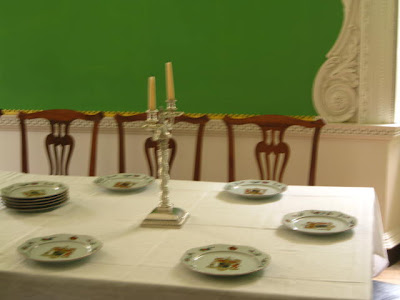It's Tuesday and that seems like a fine day to rub shoulders with some royalty. Want to come along? Having left Great Hopes Plantation, why don't we stroll down the lane to the Governor's Palace? Completed in 1722 after sixteen years of construction, it served as home to seven royal governors as well as Virginia governors Patrick Henry and Thomas Jefferson. A professor from the College of William and Mary described the Palace in a book published in 1724, when the city was just 25 years old.
"From the Church," he wrote, "runs a Street northward called Palace Street; at the other end of which stands the Palace or Governor's House, a magnificent Structure built at the publick Expense, finished and beautified with Gates, Fine Gardens, Offices, Walks, a fine Canal, Orchards, &c. . . . This likewise has the ornamental Addition of a good Cupola or Lanthorn, illuminated with most of the Town, upon Birth-Nights, and other Nights of occasional Rejoicings."
The stable, carriage house, kitchen, scullery, laundry, and an octagonal bathhouse were arranged in service yards beside the advance buildings.
 | |
| This carriage carried Queen Elizabeth II on her last trip to Williamsburg in 2007. What do the British think when they visit Williamsburg, I wonder? |
Following the hasty royal retreat, General Charles Lee of the Continental army made the Palace his headquarters until it became a hospital. Then Virginia's government ordered the structure renovated for Governor Patrick Henry. Thomas Jefferson succeeded Henry in office and residence. In 1779 he drew a floor plan of the Palace, perhaps with a view to remodeling. The government, however, moved the next year to Richmond, and nothing came of the plans. The Palace served again as a hospital in the fall of 1781, this time for American soldiers wounded in the Battle of Yorktown. Some 156 of them, and two women, are buried in the garden.

But before the War, and the disrepair it finally fell into, the Palace was home...even if it was less impressive than many of the family homes British royal governors were accustomed to back in England. Bedrooms had to accommodate both the children and their governesses. I am sure you can figure out which bed belonged to each (don't let the doll fool you!)
The Palace hosted the colony’s fashionable society and finest entertainments. The October 31, 1771, Virginia Gazette reported:
"Last Friday night being the anniversary of our Most gracious Sovereign's Accession to the Throne, his Excellency the Governor gave a Ball and an elegant Entertainment at the Palace, to a numerous and splendid Company of Ladies and Gentlemen."The magnificent ballroom is painted a dazzling blue called Palace Ballroom Wallpaper Prussian Blue. Note the harpsichord and the carpet that was definitely meant to impress!
If you forgot for a moment that you were still a subject of the Royal Crown, the watchful eyes of King George III and Queen Charlotte quickly reminded you of where your loyalty ought to lie!
Or, if the air grew stale and the talk turned to politics, you could always escape to the gardens for a quiet rendevous!
Let's finish with a stroll around the lovely gardens, my favorite part of the Palace tour.
WHAT doth avail to have a princely place,
A name of honour, and a high degree;
to come by kindred of a noble race.
Except we princely, worthy, noble be!
The fruit declares the goodness of the tree
Do brag no more of birth, or lineage then;
For virtue, grace and manners make the man.





















in awe at that grand hallway as well...!
ReplyDelete